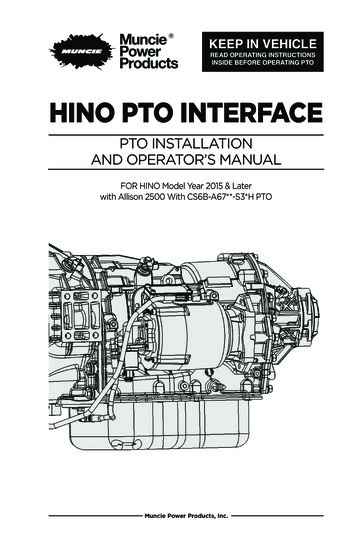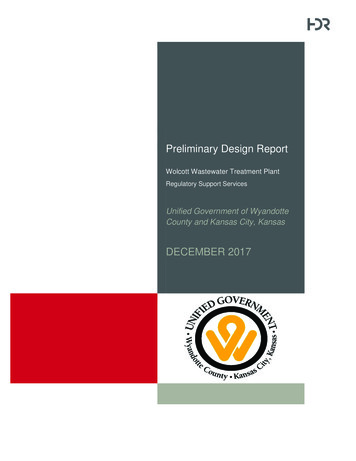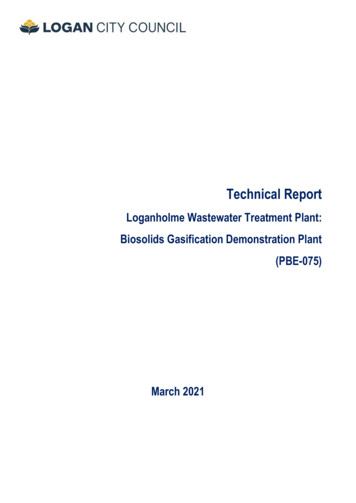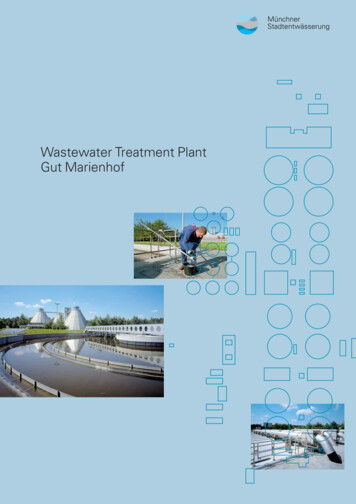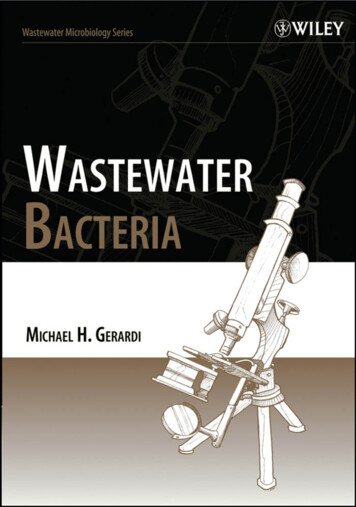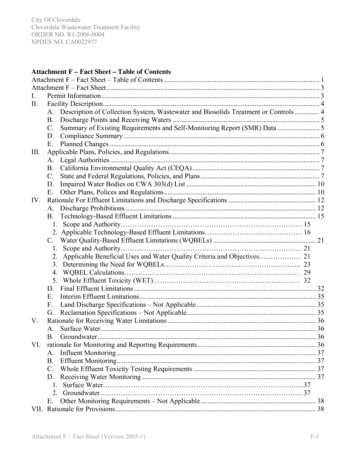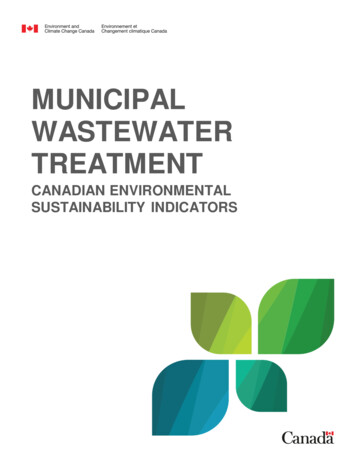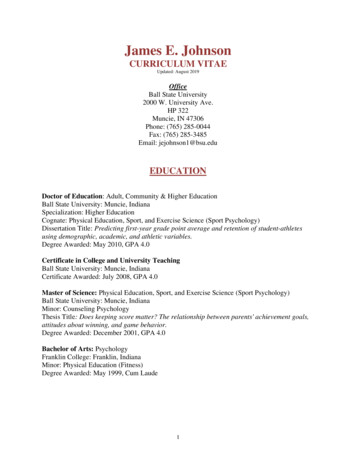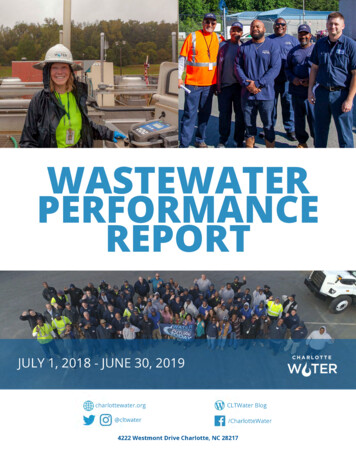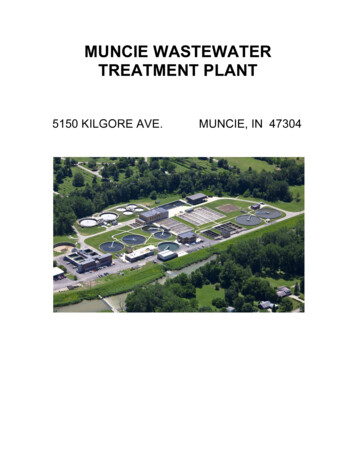
Transcription
MUNCIE WASTEWATERTREATMENT PLANT5150 KILGORE AVE.MUNCIE, IN 47304
The water we drink today has been here since thedinosaurs roamed the earth. We always have hadabout the same amount of water on the earth. Wateris evaporated into the clouds by the sun and returnedto earth when it rains. The water then filters throughsoil which helps to naturally purify it.Just think 70% of the earth is water, yet only 3% isfresh water and of that 3%, 2% is locked up in icecaps and glaciers. That leaves about .0001% forrivers and .0007% for lakes, the rest is ground water,moisture and vapor. But with so much water beingused Nature is having a problem keeping the watercleaned. So man has to help clean up the water.2
Each household uses about 176 gallons of water perday. If you think about just the people in your house,that is a lot of water. With the amount of people onearth increasing, we need to think about “WaterConservation.” This means you need to think aboutthe amount of water you use and the waste everyday.When you take long showers or let the kitchen faucetrun to let the water get cold. Small things like this canmake a big difference if enough people think about it.Today many people need to “re-use” water. Thismeans cleaning wastewater for the next person touse.3
The water you drink if you live in Muncie comes fromthe White River.White River starts as a bubbling stream out of theground about 40 to 50 miles north of Muncie. It flowspast the reservoir and is pumped from the river to theWater Treatment Plant.In Muncie the WaterTreatment Plant is called Indiana - American WaterCompany. It is located on Burlington Drive. Theyclean the water using settling tanks, sand filters, andadd chlorine to kill bacteria that can harm, humans.The water isthen pumped to homes, stores, schools and industriesfor use.When the water goes down the drain it becomes“wastewater.” The waste water flows through a seriesof pipes to a main “sewer.”Most of the waste- watercan flow by gravity, but if itcan no longer flow bygravity a lift station is built.4
This is a place where pumps can lift the water to apoint where it can again flow by gravity. It you live inDelaware County and have a septic system thewastewater will be pumped out by a Septic Serviceand driven to the Wastewater Treatment Plant. InMuncie all wastewater ends up at the MuncieWastewater Treatment Plant at an average of 16.5million gallons per day. (One gallon of water weighs8.34 lbs.) White River has an average flow of 1.2million gallons per day.The industries inMunciemustclean their usedwater before itcan be releasedto the sewers.They have small treatment plants where chemicalsand settling tanks are used to take out metals andother harmful items. They are inspected by theMuncie Bureau of Water Quality (located at theMuncie Wastewater Treatment Plant) regularly.Once the wastewater reaches the treatment plant twofine trash screens remove objects that could plug orharm pumps and equipment. Then it flows to the rawsewage pumps. These pumps lift the flow to a higherpoint so it can then flow by gravity.5
Sand, grit and other heavy material are removed bytwo “Head Cells” – which use a vortex type of flowpattern to separate lighter organic solids from theheavier inorganic ones. The heavier inorganic solidsare collected and pumped to a slow conveyor fordisposal. The water and organic solids flowdownstream to the Primary Clarifiers. The grit isdewatered and hauled to the landfill.6
From the Head Cells, the flow goes to two PrimaryClarifiers. The solids settle to the bottom and thescum is skimmed from the surface. The solids thatsettle is called “sludge.” The sludge is then pumpedto the digester for further treatment.The liquid flow goes to six “aeration tanks.” Threelarge blowers provide air to the tanks, causing thewater to bubble and mix. The air is needed for the7
“good bacteria” to grow and “eat” the remaining solidsin the wastewater that didn’t settle in the primaries.These bacteria are microscopic size bugs.Following the aeration, the “solids,” now made up of“bacteria and sludge” (webbed together to form a“floc”) are settling in four circular and two rectangularsettling tanks(Clarifiers). Some of the solids from thebottom of the Clarifiers is sent back to the aerationtanks,and some is sent to the Rotary Drum Thickener(RDT). The RDT thickens by removing some of the8
water and thickening the sludge to save room in theDigesters where it is pumped to. The remaining liquidfrom the Clarifiers flows to 3 submersible pumps.The pumps lift the flow to mono-media filters. Herethe water is filtered through Silica media. This helpswith the final “cleaning” of the wastewater. Chlorine isadded from April 1 to October 31 to help kill theremaining “bad bacteria,” that can cause illness.These are called “pathogenic.” Sulfur dioxide is thenadded to take away the chlorine.The primary and secondary sludge is pumped to thetwo “primary digesters.” Here the sludge is mixed andheated to allow a different kind of bacteria to growthat “eats” the sludge and help to stabilize it. Thebacteria breaks down the sludge particles and someof the by-products are water, methane, hydrogensulfide and other products. These digesters aremixed to keep the bacteria in contact with newincoming sludge.This heated sludge is thenpumped to one of the 4 “secondary” digesters where itcan just rest with no heat or mixing. In the secondarydigesters the solids again settle to the bottom and theliquid goes to the top. The liquid (supernatant) is sentback “to the plant” via pipes to be reprocessed. Thesolids are either hauled to farm land in liquid form, ordewatered by 4 belt presses. Belt presses dewaterthe sludge by filtration on the top belt and squeezingor compaction in the middle. The end product is a“cake” the consistency of a dryer mud pie.9
The “cleaned wastewater” then flows back into theWhite River Where it resumes its journey.List ways to conserve water around your home,school or where you go:1.10
2.3.4.The Muncie Wastewater Treatment Plant would like toinvite you out to tour the facility.NOTES AND QUESTIONS I HAVE11
The clean liquid on top flows to 3 submersiblepumps. The pumps lift the flow to monomedia filters. Here the water is filtered througha layer of silica media. This helps the final“cleaning” of the wastewater. Chlorine isadded from April 1 to October 31 to help killthe remaining “bad bacteria,” that can causeillness. These are called “pathogenic.” Sulfurdioxide is then added to take away the chlorine.The primary and secondary sludge is pumpedto the two “primary digesters.” Here thesludge is mixed and heated to allow a differentkind of bacteria to grow that “eats” the sludgeand help to stabilize it. The bacteria breaksdown the sludge particles and some of the byproducts are water, methane, hydrogen sulfideand other products. These two digesters aremixed to keep the bacteria in contact with newincoming sludge. This heated sludge is thenpumped to one of the four “secondary” digesterswhere it can just rest with no heating or mixing.In the secondary digesters the solids again settle tothe bottom and the liquid goes to the top. Theliquid (supernatant) is sent back “to the plant” viapipes to be reprocessed.The solids are dewatered by four filter belt presses.Filter belt presses dewater thesludge by filtration on the topbelt and squeezing orcompacting in the middle.The end product is a “cake”the consistency of a dryer mud pie, then hauled tothe landfill.The “cleaned wastewater” thenflows back into the White Riverwhere it resumes its journey.List ways to conserve wateraround your home, school, or where ever yougo:1.MUNCIE WATERPOLLUTION CONTROLFACILITY2.3.List questions you have about the wastewatertreatment process:1.2.3.Muncie Water Pollution Control Facility5150 W. Kilgore Ave.Muncie, IN 47304Phone – 765-747-4864Fax – 765-747-4759For more information about the Muncie Sanitary Districtplease check out the web site at:www.munciesanitary.com
The water we drink today has been here sincethe dinosaurs roamed the earth. Wealways have had about thesame amount of wateron the earth. Water isevaporated into the clouds bythe sun and returned to earth when it rains.The water then filters through soil which helpsto naturally purify it.Just think 70% of the earth iswater, yet only 3% is freshwater and of that 3%, 2% islocked up in ice caps andglaciers. That leaves about0.0001% for rivers and 0.0007% for lakes, therest is ground water, moisture and vapor. Butwith so much water being used Nature ishaving a problem keeping the water cleaned.So man has to help clean up the water.Each household uses about 176 gallons ofwater per day. If you think about just thepeople in your house, that is a lot of water.With the amount of people on earthincreasing, we need to think about “WaterConservation.”This means you need to think about theamount of water you use and wasteeveryday. When you take longshowers or let the kitchen faucetrun to let the water get cold. Smallthings like this can make a big difference ifenough people think about it. Today manypeople need to “re-use” water. This meanscleaning the wastewater for the next person touse.The water you drink if you livein Muncie comes from theWhite River. White River startsas a bubbling stream out of theground about 40 to 50 miles north of Muncie.It flows past the reservoir and is pumped fromthe river to the Water Treatment Plant.In Muncie the Water Treatment Plant is calledIndiana – American Water Company. It islocated onBurlingtonDrive. The water is cleaned using settlingtanks, sand filters, and add chlorine to killbacteria that can harm humans. The water isthen pumped to homes, stores, schools andindustries to use.When the water goes down thedrain it becomes “wastewater.”The wastewater flows through aseries of pipes to a main “sewer.”Most of the wastewater can flowby gravity, but if it can no longer flow bygravity a “lift station” is built. This is aplace where pumps lift the water to a placewhere it can again flow by gravity.If you live in Delaware Countyand have a septic system, thewastewater will be pumped out by a SepticService and driven to the Muncie WaterPollution Control Facility.In Muncie all wastewater ends up at theMuncie Water Pollution Control Facility at anaverage of 16.5 million gallons per day. (Onegallon of water weighs 8.34 pounds). WhiteRiver has an average flow of 1.2 million gallonsper day.The industries in Muncie must clean their usedwater before it can be released to the sewers.They have small treatment plants wherechemicals and settling tanks areused to take out metals and otherharmful items. They are inspected regularly bythe Muncie Bureau of Water Quality (locatedat the Muncie Water Pollution ControlFacility).Once the wastewater reaches the treatmentfacility, two fine screens remove large objectsthat could plug or harm pumps andequipment. Then it flows to the raw sewagepumps. These pumps lift the flow to a higherpoint so it can then flow by gravity. Sand, gritand other heavy material settle into 2 HeadCells using vortex energy to separate the heavyinorganics. The grit is dewatered and hauled tothe landfill.From the Head Cells, the wastewater flows totwo primary settling tanks. The solids settle tothe bottom and the scum is skimmed from thesurface. The solids that settle is called “sludge.”The sludge is then pumped to the digesters forfurther treatment.The liquid flow goes to six “aerationtanks.” Three large blowers provideair to the tanks, causing the water tobubble and mix. The air is needed for the“goodbacteria” to grow and“eat” theremaining solids in thewastewater that didn’t settle in the primaries.These bacteria are microscopic sized bugs.Following aeration, the “solids,” now made upof “bacteria and sludge” (webbed together toform a “floc”) are settled in four circular andtwo rectangular settling tanks. Some of thesolids from the bottom is sent back to theaeration tanks, some is sent to the sludgethickener process before being sent to thedigesters for further treatment.
Muncie all wastewater ends up at the Muncie Wastewater Treatment Plant at an average of 16.5 million gallons per day. (One gallon of water weighs 8.34 lbs.) White River has an average flow of 1.2 million gallons per day. The industries in Muncie must clean their used water before it can be released to the sewers. They have small treatment .
